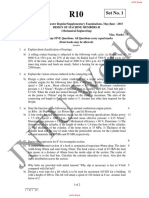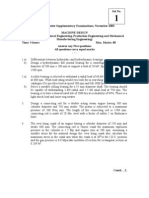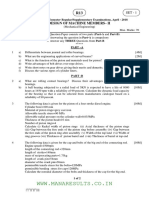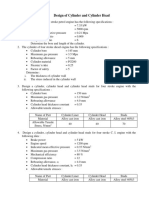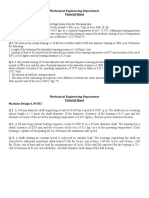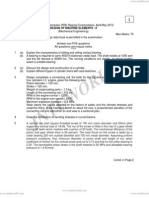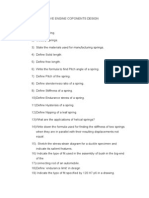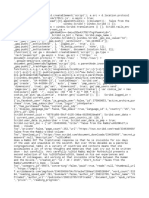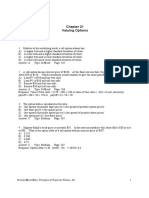JSS MAHAVIDYAPEETHA
JSS ACADEMY OF TECHNICAL EDUCATION,
NOIDA DEPARTMENT OF MECHANICAL
ENGINEERING Subject: MACHINE DESIGN -
II(RME-603)
B. Tech. Sixth Semester
Assignment V: CO5
C319.1 Interpret and make use of design requirements, procedures and standards in design
and analyze the mechanical components subjected to static and fluctuating loads for
finite and infinite life
C319.2 Design of riveted and welded joints for various structures and Application of the
various aspects of shaft design subjected to static and dynamic loading.
C319.3 Analyze the forces acting on gear tooth and design spur & helical gear based on
beam strength and wear strength as per Indian standards
C319.4 Select Journal bearing performance characteristic and determine the heat generated in
hydrodynamic journal bearing and also select rolling contact bearing from the
manufacturers catalogue subjected to constant and varying load
C319.5 Design of Friction Clutches and IC engine parts to meet the required
specifications.
1. The cylinder of a four-stroke diesel engine has the following specifications: Brake power = 5
kW Speed = 600 rpm Indicated mean effective pressure = 0.5 MPa Make suitable assumptions
and calculate: (i) bore and length of the cylinder liner (ii) thickness of the cylinder liner (iii)
thickness of the cylinder head (iv) size, number and pitch of studs.
2. A four stroke diesel engine has the following specifications: Brake power = 5 kW ; Speed =
1200 r.p.m. ; Indicated mean effective pressure = 0.35 N / mm 2 ; Mechanical efficiency = 80
%. Determine: 1. bore and length of the cylinder; 2. thickness of the cylinder head ; and 3. size
of studs for the cylinder head.
3. The following data is given for a four-stroke diesel engine: Cylinder bore = 250 mm Length of
stroke = 300 mm Speed = 600 rpm Indicated mean effective pressure = 0.6 MPa Mechanical
efficiency = 80% Maximum gas pressure = 4 MPa Fuel consumption = 0.25 kg per BP per h
Higher calorific value of fuel = 44 000 kJ/kg Assume that 5% of the total heat developed in the
cylinder is transmitted by the piston. The piston is made of grey cast iron FG 200 (Sut = 200
N/mm2 and k = 46.6 W/m/°C) and the factor of safety is 5. The temperature difference
between the centre and the edge of the piston head is 220°C. (i) Calculate the thickness of
piston head by strength consideration. (ii) Calculate the thickness of piston head by thermal
consideration. (iii) Which criterion decides the thickness of piston head? (iv) State whether the
ribs are required. (v) If so, calculate the number and thickness of piston ribs. (vi) State whether
a cup is required in the top of the piston head. (vii) If so, calculate the radius of the cup
4. Determine the dimensions of small and big end bearings of the connecting rod for a diesel
engine with the following data: Cylinder bore = 100 mm Maximum gas pressure = 4 MPa (l/d)
ratio for piston pin bearing = 2 (l/d) ratio for crank pin bearing = 1.3 Allowable bearing
pressure for piston pin bearing = 12 MPa Allowable bearing pressure for crank pin bearing =
7.5 MPa
5. The following data is given for the cap and bolts of the big end of connecting rod: Engine
speed = 1800 rpm Length of connecting rod = 350 mm Length of stroke = 175 mm Mass of
reciprocating parts = 2.5 kg Length of crank pin = 76 mm Diameter of crank pin = 58 mm
Thickness of bearing bush = 3 mm Permissible tensile stress for bolts = 60 N/mm2 Permissible
bending stress for cap = 80 N/mm2 Calculate the nominal diameter of bolts and thickness of
cap for the big end.
�6. What is the difference between clutch and flange coupling?
7. An automotive single plate clutch consists of two pairs of contacting surfaces. The outer
diameter of the friction disk is 270 mm. The coefficient of friction is 0.3 and the maximum
intensity of pressure is 0.3 N/mm 2. The clutch is transmitting a torque of 531 N-m. Assuming
uniform wear theory, calculate: (i) the inner diameter of the friction disk; and (ii) spring force
required to keep the clutch engaged.
8. A cone clutch is used to connect an electric motor running at 1440 rpm with a machine which
is stationary. The machine is equivalent to a rotor of 150 kg mass and radius of gyration as 250
mm. The machine has to be brought to the full speed of 1440 rpm from stationary condition in
40s. The semi-cone angle a is 12.5°. The mean radius of the clutch is twice the face width. The
coefficient of friction is 0.2 and the normal intensity of pressure between contacting surfaces
should not exceed 0.1 N/mm2. Assuming uniform wear criterion, calculate: (i) the inner and
outer diameters; (ii) the face width of friction lining; (iii) the force required to engage the
clutch; and (iv) the amount of heat generated during each engagement of clutch.
9. A multi-disk clutch consists of two steel disks with one bronze disk. The inner and outer
diameters of the contacting surfaces are 200 and 250 mm respectively. The coefficient of
friction is 0.1 and the maximum pressure between the contacting surfaces is limited to 0.4
N/mm2. Assuming uniform wear theory, calculate the required force to engage the clutch and
the power transmitting capacity at 720 rpm
10. A centrifugal clutch, transmitting 18.5 kW at 720 rpm, consists of four shoes. The clutch is to
be engaged at 75% of the running speed. The inner radius of the drum is 165 mm, while the
radius of the centre of gravity of each shoe, during engaged position, is 140 mm. The coeffi
cient of friction is 0.25. Calculate the mass of each shoe.



